So you’re interested in mining cryptocurrency, but you’re not sure where to start? No problem, this guide is all you need to set up your own headless litecoin mining rig—even if you have absolutely no experience with this sort of thing.
First, let’s get the obvious question out of the way: why litecoins? After all, bitcoins are worth more, right? The simple answer is that at the time of this writing, litecoins are currently the most profitable cryptocurrency to mine when you take into account how much each coin is worth, and the time required to mine one. Rest assured that if the situation changes, and another cryptocurrency suddenly surpasses litecoin as the best mining option, the rig outlined in the guide should have no problem switching over to a new coin.
This guide will be broken into several parts, each focusing on a different aspect of building your first mining rig. First, let’s take a look at what you’ll need in terms of hardware to put a respectable miner together.
Build your own Litecoin Mining Rig, part 1: Hardware
4/06/2017: This guide is roughly three years old. Please don’t attempt to buy any of the hardware recommended here—it’s quite obsolete! If you’re looking for information about modern GPU mining, please click here for my updated 2017 guide on mining Ethereum.
Here is the list of hardware that I recommend:
| Motherboard | ASRock 970 Extreme4 |
$98 |
| Processor | AMD Sempron 145 |
$38 |
| Memory | 4GB G.SKILL DDR3 SDRAM (2 x 2GB) |
$46 |
| Power Supply | Seasonic 860w Platinum PSU |
$199 |
| GPUs | 3 x MSI Radeon HD 7950 3GB GDDR5 (Twin Frozr) |
$319 each |
| (optional) | 3 x PCI-E riser cable | $5 each |
| (for dummy plugs) | 68 ohm 1/2 watt resistors | $3 |
Update 11/26/2013: The Radeon 7950 video cards are sold out pretty much everywhere. They’re still the best option for mining if you can find them, but if you can’t, then the new Radeon R9 280X cards are likely your best option. They do consume a fair bit more power though, so you”ll want to upgrade your power supply as well (this 1250w Seasonic should support three 280X GPUs without problems). As for brands, I recommend these Sapphire, Gigabyte, and MSI 280X cards for now. I’ll be updating the rest of my guide at some point in the near future with optimal settings for the 280X, so stay tuned.
Update 12/01/2013: If you’re trying to put a rig together, you’ve probably noticed that the above video cards have become nearly impossible to find. I’ve received a few messages from folks that are having some good results using the R9 290 cards, although they’re a fair bit more expensive than the 280X. If you’re itching to build a rig ASAP and can’t find a 7950 or 280X, then you might consider the 290. It looks like all of the current 290 cards are using AMD’s reference cooling design at the moment, so brand probably doesn’t matter too much. Although given a choice, you usually can’t go wrong with Sapphire, Gigabyte, and MSI. Again, remember to pick up a fairly powerful PSU if you’re going to run 3 of these in a rig.
You will also need a USB stick (8GB or larger, this one is fine) if you’re using Linux as your OS, or a harddrive (a cheap SATA drive of any size will do) if you’re using Windows. I will cover setup on both Linux and Windows in the next sections of this guide, as well as the pros and cons of each.
The video cards may be difficult to find, as they’re popular and often sell out. You can substitute nearly any 7950-based GPU, but if you have a choice, go for the MSI or Sapphire cards. They’re not voltage-locked and will save you some electricity in the long run. I have the MSI card that I recommended in all of my rigs, but I’m told that this (and also this) Sapphire card is also a good choice.
The motherboard, CPU, and RAM are all relatively unimportant. The motherboard simply needs to have enough PCI-E slots to host your three GPUs (if the recommended board isn’t available, here is another, or if you can’t find either ASRock, this Gigabyte board is a good alternative). The CPU will essentially sit idle, as all of the actual mining is done by the GPUs. The Sempron 145 is an excellent choice here because it’s cheap and draws very little power (if the Sempron is unavailable, this one is also a fine choice). If you’re going with Linux, you can get away with even less than 4GB of RAM, but I’d stick to that as a realistic minimum on Windows.
The power supply is important, and you don’t want to skimp on it. The Seasonic that I’ve recommended is extremely solid and 93% efficient, which will help keep power consumption to a minimum. It’s also modular, which is really nice if you’re putting this together in a plastic crate like I recommend.
The PCI-E risers aren’t strictly necessary, as all 3 GPUs will fit on the motherboard without them. However, airflow will be extremely limited due to the close proximity of the cards, and I really don’t recommend setting them up that way long-term. The riser cables allow you to position the GPUs off of the motherboard in a more spaced-out fashion. I dropped the temperature of my GPUs by nearly 10 degrees Celcius by simply using risers to separate them. Availability and pricing on Amazon is constantly changing, so check eBay if you can’t find them.
Important: you may also need to create dummy plugs for each of your GPUs. Some operating systems will idle video cards that do not have an active monitor connection, which will obviously kill your mining performance. Dummy plugs “trick” your OS into thinking a monitor is connected, thus preventing attached GPUs from being idled. You just need a few resistors ($1-2 at Radio Shack if they’re not available at Amazon) and these instructions to create your own plugs.
So you’ve got nearly $1400 worth of hardware, but no place to put it, as I haven’t mentioned a case. I highly recommend against trying to cram 3 GPUs into a conventional PC case. A plastic crate or two works far better due to the tremendous heat that the video cards will give off. Added bonus: they’re cheap!
Here is what you’ll need to create a simple DIY plastic crate housing for your miner:
| Plastic Crate |
$5 each |
| Plastic stand-offs | $4 |
| 6 x #4 3/8″ wood or metal screws | $1 |
| Brace to rest GPUs on (I used two of these) | $4 |
| a few cable ties (8″ or so) | $2 |
| power switch & LED (optional) | $6 |
You can get plastic crates in most home improvement stores if you don’t want to ship it from Amazon. I picked mine up at Lowe’s for under $5 each. You should be able to get everything else on the list at Lowe’s if you happen to have one near you, too. As far as tools go, you’ll need a drill and a knife capable of cutting into whatever plastic crate you buy.
Assembly Steps:
First, attach your CPU & heatsink/fan to your motherboard, and place your RAM into the memory slot(s). Then follow the general steps below to mount everything into your plastic crate.
Click the images for a close-up look at each step.
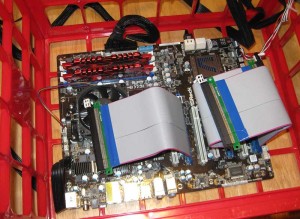 Place plastic standoffs on the bottom of your plastic crate, and rest your motherboard on top of them. Make sure that all of the essential ports are accessible (SATA, USB, keyboard, mouse, etc). Use your knife to cut away pieces of the crate if necessary so that all ports you plan to use are exposed. Then plug your riser cables into the PCI-E slots of your motherboard.
Place plastic standoffs on the bottom of your plastic crate, and rest your motherboard on top of them. Make sure that all of the essential ports are accessible (SATA, USB, keyboard, mouse, etc). Use your knife to cut away pieces of the crate if necessary so that all ports you plan to use are exposed. Then plug your riser cables into the PCI-E slots of your motherboard.
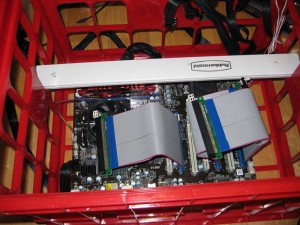 Place your brace (either the plastic guards that I recommended, or a cut yardstick, or whatever you have that works) so that it is sitting above the motherboard, high enough for your GPUs to rest on. Cut the brace so that an inch or two sticks out on either end of the crate.
Place your brace (either the plastic guards that I recommended, or a cut yardstick, or whatever you have that works) so that it is sitting above the motherboard, high enough for your GPUs to rest on. Cut the brace so that an inch or two sticks out on either end of the crate.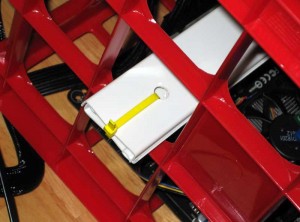 Drill holes in your brace so that you can secure it with cable ties (see image). Do not simply rest the brace on the crate! An accidental bump can cause it to fall into the crate, along with ~$1000 worth of GPUs if you do that!
Drill holes in your brace so that you can secure it with cable ties (see image). Do not simply rest the brace on the crate! An accidental bump can cause it to fall into the crate, along with ~$1000 worth of GPUs if you do that!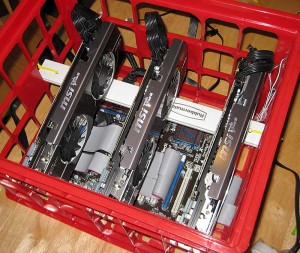 Connect each GPU to it’s corresponding riser cable, resting the bracket end on the lip of the crate and the other end on your brace.
Connect each GPU to it’s corresponding riser cable, resting the bracket end on the lip of the crate and the other end on your brace.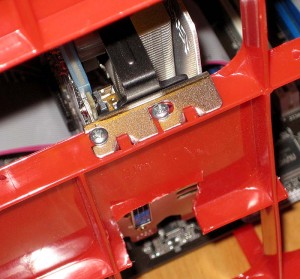 Screw each GPU down into the lip of the crate. If you drill small pilot holes ahead of time (mark where to drill with a sharpie), this is much easier.
Screw each GPU down into the lip of the crate. If you drill small pilot holes ahead of time (mark where to drill with a sharpie), this is much easier.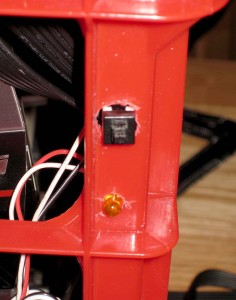 If you have a power switch and LED, mount them into one of the crate’s corners. I was pretty sloppy with mine, but it’s functional.
If you have a power switch and LED, mount them into one of the crate’s corners. I was pretty sloppy with mine, but it’s functional.
You’re done! Simply connect everything to your power supply and you should be ready to power your rig on for the first time. If you have a second crate, you can put your power supply in there (along with your harddrive if you’re using Windows), and stack it under your main crate to save some space.
In the next part of this guide, I’ll show you everything you need to do to start mining under Linux (and Windows will follow shortly after)!



 April 18th, 2013
April 18th, 2013  CryptoBadger
CryptoBadger 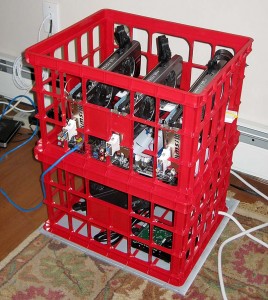
 Posted in
Posted in  Tags:
Tags: 


Hi crytobadger thanks for the great guide.
I just had a question after having it running with
all 3 graphic card it seems to stop mining after a
few hours. (All cards seem to be still running but the
mining has stopped?)after rebooting only 2 cards run.
This does not happen when I run it with just 2 cards.
However they don’t seem to get extremely hot with 3 the middle
one reaches 102 Celsius, could the be an issue?
I have not got the pci extenders as I had to buy them overseas.
The only thing different to your rig is
that im running a corsair HX850 could this have anything
to do with my problem? This is my first rig
Any helps is welcome.
Cheers
102C is very hot – are you using risers? You probably don’t want to run your GPU that hot; you’ll likely significantly reduce its lifespan. If you don’t have risers yet, try pointing a deskfan at your rig in the meantime so that air blows between your GPUs – that should help cool it down.
By default, I believe cgminer will shut down GPUs that go over 85C for 5 minutes so they can cool off. That may be why you see that only two are working.
Are dummy plugs also needed on Linux?
They are only for windows right?
The dummy plugs shouldn’t be needed on linux – if you use a different distro and/or driver version, it’s possible that you might need them.
I needed them on windows to make everything work properly. Some people have reported not needing them, though.
Hi!. great tutorial but i need to point out that the gigabyte card is NOT supported on xubuntu ,
So dont buy it!
Gigabyte GA-990FXA-UD3
Gigabyte GA-990FXA-UD5
Are not supported on USB or Ethernet controllers.. so skip these , i bought one but ended upp buying another card.
This is not true, I mine with Xubuntu and a Gigabyte GA-990FXA-UD3.
I also had the described problem until I found a BIOS setting called IOMMU that was disabled by default. I just changed this to enabled in the BIOS and everything started to work, just like magic.
Hi johan, Great.
Does that solve the Ethernet issue aswell?
Yes, it solves both USB and Ethernet issues. I had both of them, I spent some time researching this problem … I was very close to order another board aswell, I am glad I didn’t since it seems to work great after the BIOS reconfig.
I confirm everything ok with the gigabyte card after bios settings:
cgminer version 3.1.0 – Started: [2013-05-21 11:44:06]
——————————————————————————–
(1s):1.077M (avg):1.080Mh/s | A:5520 R:677 HW:0 U:28.6/m WU:995.7/m
ST: 2 SS: 0 NB: 549 LW: 2831 GF: 0 RF: 0
Connected to pool.worldcoinpool.com diff 31 with stratum as user
Block: d8eb44409953ff37… Diff:757K Started: [14:56:30] Best share: 257K
——————————————————————————–
[P]ool management [G]PU management [S]ettings [D]isplay options [Q]uit
GPU 0: 81.0C 3047RPM | 538.0K/540.5Kh/s | A:2774 R:352 HW:0 U:14.36/m I:20
GPU 1: 76.0C 2572RPM | 537.9K/540.0Kh/s | A:2752 R:325 HW:0 U:14.24/m I:20
——————————————————————————–
Doing some worldcoin mining ….
Thanks a billion…I have been working on this problem for over a week. Solved!!!
Firstly thanks for this great guide! I’ll be sending over some LTC soon.
I just wanted to feed back as I tried the MSI and the Sapphire Vapor-x cards against each other (I built two linux rigs, but with one card each to start with. I plan to add to them as budget allows). The Sapphire seems much easier to keep cool and uses less power, I guess as a result of not working the fans so hard?
I do have these running in quite a warm room though, so the differences might not be as noticeable in cooler surroundings.
Hi cryptobadger,
Have assembled the rig, All components as you recommend, except with Sapphire 7950. Problem: when powered up, fans are running, leds are on, but no video output (radio shack DVI-I adapter to VGA). Monitor works fine on regular computer. Where do I start to troubleshoot. This IS my first experience ever with computer work. Thanks a million for any insights to this problem.
Start with just one video card until you’re up and running. Make sure that you’ve plugged the PCI-E power connectors into the GPU (and that they’re snug – they should click). Make sure that you’ve also plugged both power connectors into the motherboard, that your RAM is seated correctly, and that you’ve plugged the CPU fan into the header on the motherboard.
Do you see the two-digit troubleshooting codes cycle when the motherboard powers on (red LED built directly onto the board)? Does a code stay lit after the power has been on for 10+ seconds? If so, look that code up in the motherboard manual, it will tell you what’s wrong.
Thanks Cryptobadger, I didn’t catch that there was a separate 12v pwr to CPU. Did I mess something up by starting the motherboard without the CPU powered? Ram (8gb) is in A1 and B1 and tight. 12v pwr to CPU and main pwr to board. One card installed in pcie #2 slot. CPU fan running, both card fans running. The LED displays 00 and stays on. After attaching the CPU pwr cord, still no output to monitor. Further advice? Really appreciate your availability and patience!
I don’t see code 00 in the manual, but the LED should go dark shortly after start up if all the tests passed successfully. Try moving the video card to the first PCI-E slot (the one closest to the CPU socket) – some motherboards expect the primary display device to be there. If that doesn’t work, try clearing the CMOS (there is a button on the motherboard you can press to do that; check the manual for the location). You can also try removing one of the RAM sticks, although I doubt the issue is memory-related.
If everything is hooked up properly, and none of these things work, it’s possible that you have a defective piece of hardware (likely the motherboard). Hopefully that isn’t the case and it was just the location of the GPU!
Cryptobadger, sure hope I’m lucky enuf to catch you at your computer in this moment. Update: I found bent pins on the cpu due to my total ignorance about install care, but painstakingly straightened them and now have finished updating BIOS. Now what? You’re talking to a complete novice, and all I get on exiting bios is the repeating line “reboot and select proper boot device…and press a key” How do I install Xubuntu (I downloaded the install image using my regular computer and saved it to a flash drive to have it ready)
If you created a bootable Xubuntu USB stick, you should be able to insert it into one of the USB ports on your mining rig, and have it boot up into the installer automatically. From there, you should be able to follow the guide.
I’m trying to install 3+ R7950 twin frozr 3GDS graphics cards onto a ASRock 970 Extreme4 mother board- http://imgur.com/w2VGkDJ&BLz1VXX- I have 3 –
PCIe x1 -> x16 Adapter Extender Cable w/ Molex Connector – http://imgur.com/w2VGkDJ&BLz1VXX#1 – There is only two x1 slots for the graphics cards on the board. Is there an easy way to install all 3 graphics cards with this equipment. using 2 of the risers and putting one card onto the board directly? Or should I use different risers for this setup. Any help or guidance is appreciated. Thank you!
You should be able to plug the 1x side of the riser cable into the 16x PCI-E slot. Just plug it into the notched end of the 16x slot so that it fits correctly; it’s ok that the rest of the 16x slot stays empty.
Hi Everyone,
The last time I tinkered with computer parts was in the early 80’s and the computer I had back then was a TRS 80. I strayed away from the computer world after that era and never got back into it. As a result, I have NO tech knowledge whatsoever since things have advanced about a 1000% since my TRS 80.
My interest in crypto currencies however has brought me back into attempting to better understand the tech world. I came across CryptoBadger’s site and after reading his excellent guide on building a LTC mining-rig, I decided to take a risk and build one.
Well, despite my limited (none) knowledge of computer hardware, I had no difficulties in putting together the hardware. Everything worked properly, but then I hit a snag. I had a significant amount of trouble getting CGMiner to function properly.
Frustrated and not understanding what to do, I reached out to CryptoBadger himself and asked for help. He responded to me quickly and advised me that he would be happy to help.
He spent several hours during the evening and into the night and then several more hours the next day assisting me in trying to get things working. After checking everything, it turned out that my OS was the problem. CryptoBadger got my rig up and running.
I’m signed up with Give-Me-LTC and thanks to CryptoBadger my hash rate is well above 1900KH/S.
Thank You Very Very Much Sir!!
You’re very welcome; it was a pleasure helping you out – thanks for the kind words! =)
I was thinking about plastic case too but i’m worried about static..
You can’t ground yourself on plastic.
Quck Question,
Any reason you cant put a 4th 7950 GPU if you are running linux?
Thanks for all the help,
Mike
You can certainly add a 4th (or even 5th) GPU if you keep a few things in mind. Check out my FAQ regarding expanding to 4-5 GPUs.
How many GPUs does the ASRock 970 Extreme4 handle?
Up to five, as long as you keep a few things in mind when connecting that many.
Awesome guide. Ive been sifting through some AMD GPU’s that are available to buy in the UK, it all looks very complicated they all look so similar. I know you said any would do, I’m just worried about their efficiency over time. Could you recommend a specific one I can get here in ‘blighty? As similar to the one in your guide, Ive checked all three links but amazon does not have the exact one you pointed to. Or at least tell me what I should be looking for in the specs? Much appreciated.
Sure, check out this Sapphire card on amazon.co.uk. If that link doesn’t take you directly to the GPU, search for “Sapphire AMD Radeon HD 7950 Graphics Card with Boost”, and it will be the first result. I don’t have any of these cards personally, but I’ve read that they’re excellent for mining, and the description on Amazon’s page indicates that they’re not voltage-locked. You should be able to use the cgminer and Afterburner settings that I recommend with these cards without issues.
Im thinking I would like to use my RIG (from time to time) for something different… So i guess ill get another (more powerfull) CPU, will this AMD Athlon II X2 270 Regor 3.4 , with an AM3 socket… what do you think?
It depends on what else you plan to do. If you plan to play games, that CPU might still be a pretty large bottleneck. For everything else (office applications, image editing, web browsing, etc), it’s a good choice as it’s a decent bit more powerful than the Sempron, but still consumes relatively little power.
If you do want to play games, I’d recommend a more powerful CPU – something like this, perhaps.
Hi cryptobadger, excellent guide, especially the Linux part. I ran into a snag though. Is there a trick to getting more then one GPU running? I got my mining rig working with one card, but when I try to add a second I just keep getting either dr debug code 79(csm initialization) or code 9A(usb initialization is started). I get the 79 code when I enable IOMMU, I thought that would help.
I have the asrock 970 extreme 4 motherboard, 3 sapphire 7950 OC cards, 850 watt rosewell PSU, semipron 145, 4gb geil ram with xbunto on a 16GB usb stick. I have both the 20 and 8 pin power cords hooked up to the motherboard and im using the two 6-pin power cables on each card
I have tried running different cards(only 2 so far) in different slots one at a time and they work just fine if there’s just one, but when I try two cards, the motherboard goes through the dr debug coded once up to 99 and then it goes through them again and gets stuck. After that if I unplug one of the cards (either one) and clear the CMOS, it goes to code 99 then off and I can get the rig to boot again.
I’ve tried it once with the crossfire cables and that wasn’t it. I tried disabling usb 3.0 and using the black USB port for the stick, didn’t work either. I can’t think of what else to try.
Any help would be greatly appreciated.
That is odd. It sounds like you’ve gone through most of the troubleshooting that I’d normally recommend already. If you’re using risers, try connecting the video cards directly to the motherboard instead. Also try moving your RAM into the other pair of slots.
I’m not familiar with the Rosewill PSU – if it isn’t a single-rail model, make sure that you’re not overloading one of the rails (check your manual and make sure that the GPUs & motherboard are spread across multiple rails).
It’s possible that you may have a defective motherboard, unfortunately. You shouldn’t need to do anything special to get the additional GPUs to work, and if it refuses to boot with more than one card connected you may need to RMA it.
Quick question, does the motherboard you recommend support up to 5 gpu’s? I’ve built the rig to your exact specs but want to use 5 cards.
The mother board currently has 2 extra PCIE 1x slots, can those be used simultaneously? Or are the PCI slots usable?
Thanks again!!
Yes, the motherboard in the guide will support up to 5 GPUs. You’d connect the additional two GPUs via the PCI-E 1x slots (with powered 1x to 16x riser cables). The PCI slots are not usable for additional GPUs.
Just make sure that you keep these things in mind when adding additional GPUs.
That’s perfect.
Just to confirm though, the 1x slots don’t need powered risers to operate if I’m already using powered risers on 2 of the 3 16x slots, correct?
For example, this is the breakdown of riser cables:
GPU 0: sits directly on motherboard (could use an unpowered 16x if I wanted to)
GPU 1: 16x POWERED riser
GPU 2: 16x POWERED riser
GPU 3: 1x unpowered riser
GPU 4 1x unpowered riser
That should work, no?
Thanks Again!!
That should work fine. The important thing is that you don’t have more than 3 unpowered risers (cards connected directly to the motherboard count as unpowered).
I enjoyed reading your guides…
I see your guide focuses on 7950s – is there a reason why you did not use 5970s I know these are more expensive but they do have a better hash rate than 5950s at least with Bitcoin, is that not the case with Litecoin.
Also why choose Litecoin over Bitcoin? I am interested in your opinion since I am just learning.
I apologize if I missed the answer
The 5970 does about 700 Kh/sec in scrypt mining, which is less than 10% better than the 7950. It draws ~50% more power though, so unless your electricity is free, it’s generally a poor choice – especially since it costs quite a bit more.
When I originally wrote the guide, mining litecoins was quite a bit more profitable than bitcoin mining. Even if you didn’t want to hold onto a bunch of litecoins, you could simply trade your litecoins for bitcoins on one of the exchanges and end up with far more bitcoins than you’d get by mining bitcoins directly. However, in the last few days, litecoin has fallen below bitcoin in profitability due to the increase in difficulty and drop in price.
I wrote a short article explaining how to figure out which coin in the most profitable to mine (and how to trade for bitcoin on the exchanges as you go, if you’re not interested in holding a bunch of different altcoins).
Thank you so much for taking the time to answer, your answers make perfect sense and have helped add to my knowledge.
I will study your article on alt coin also.
Some graphics cards come with 6 pin and 8 pin power sockets (which provide 75W and 150W) on the card so get power directly from the PSU. In this case do you still need powered risers or not?
Yes, you still need powered risers if you connect more than 3 GPUs to the motherboard (for 3 or less, unpowered is fine).
Even though the video cards have PCI-E power connectors to draw power from the PSU, they also draw power (up to 75 watts) from the motherboard.
Hi CryptoBadger,
So I started building today only to find out that my Seasonic Power Supply came with just 2 PCIe power cables for the GPU’s. Needless to say I need 3.
Can you suggest a replacement cable through a link on Amazon? That is, unless there are other options. I’ll be out and about tomorrow, so I should be able to find one at a different store, maybe Radio Shack or Best Buy, but since I can wait a bit perhaps Amazon will have the best price.
Also, the cables seem to be pretty short for trying to place the Seasonic in a different crate on the bottom as you suggest. is there a longer one available?
Thank you for your time.
Joe
Did you buy the 860w Seasonic that I recommend? If so (and you’ve probably already realized this), there are enough PCI-E power adapters for all 3 GPUs, it’s just that Seasonic gave you two different types, so it’s a bit confusing at first.
You should have two Y-adapters (one end goes into the PSU, and the other two ends go into the 6+6/8 pin connectors on your GPU.
You should also have two single adapters – you’ll need to use both of them to power the last GPU (one end of each goes into the PSU, and the other end of each goes to one of the 6+6/8 pin power connector on the GPU).
Placing the PSU in a second crate below the main crate is a bit of a reach when you initially set it up. I hook everything up to the various components first, and then route all of the various cables through the floor of the main crate. Then I plug everything into the PSU in one go. It it resting on it’s side in the lower crate, but that’s fine.
Thank you. I’ll look into that on my next day off and go from there.
Well, I’m working on this again, and for the life of me, I can’t find the adapters that you are talking about. I have a CPU cable that is extra with a 12 pin plug but only 8 pins have the copper inlays in them to make a connection which leads to an 8 pin plug which could go into one of the slots on the GPU, leaving one open and unused.
I have a bunch of other connectors but from what I can tell none of them would make the connections you are talking about. (And I did buy the recommended PSU.)
It’s possible they didn’t send me what you are talking about, but even more probable that i don’t know what i am looking for. Can you post pictures of what is what, and how to hook them up, or in the event I don’t have what you are talking about, is there a place where I can buy just another 12 pin PCI-E cable that connects via 2 X 8 pins? I’m looking everywhere for one online, and outside of buying a whole nuther PSU, I’m coming up with a whole lotta nothin’.
Thanks for your help.
Ah, it sounds like you’re using a PCI-E cable meant for a video card to connect to the CPU (the cable labeled “CPU” is meant for that). That’s fine and won’t hurt anything, but if you swap them, you should then have two of those PCI-E cables. You’ll need to use both of them to hook up the remaining GPU (each one plugs into one of the 6/8 pin power connectors on the video card). Let me know if you’re still unclear and I’ll take a picture of mine.
I suppose it’s also possible that Seasonic just shorted you one cable. If that is the case, I’d contact them directly and just let them know – I’m sure they’ll send you a replacement free of charge.
Well I do have the CPU labeled cable to the CPU. I have two PCI-E cables hooked up directly (they are dual 8 pins) to the GPU and the one cable that has me perplexed also says CPU, so I think they sent me two CPU cables by mistake.
Since I wasn’t sure, I ordered from a separate company another 12 pin to dual 8 pin cable. Should be here in a week or so. That’ll fix it even if it’s an additional expense. I’ve been stuck on this situation for 2 weeks now.
hi mate, how many watts does this use roughly at maximum performance?
thanks.
That is actually in the article 🙂
Approximately 800 watts in full power without undervolting and approximately 700 watts if undervolting.
A Kill-a-watt device though would be more precise
Is there any reason why the computer becomes so sluggish when mining – even moving the mouse is extremely slow and jerky.
That is actually what happens when mining LTC.
If you also want to use the PC you should lower intensity; be aware though that you will lose in hashing power
Mining uses nearly 100% of your GPU power, so even fairly trivial tasks like repainting the screen get delayed. Basically, your video card can’t keep up with painting the mouse pointer where it actually is when mining.
As SkyNet said, you can change your cgminer settings so that less than 100% of your GPU power is allocated to mining, but you’ll lower your hashrate significantly.
Is it possible to run 5 GPU with this rig?
Yes. Here are a few things to keep in mind if you want to run more than 3 GPUs.
Looks like 3 cards is enough come to think of it. I don’t like surprises when it comes to hardware failures.
Cheers for the response. 🙂
@CryptoBadger what temperature do your 3×7950 run at. Using your exact configuration I get 72,92,90 C, all seems really hot. I dont know what is considered a safe range.
It’s safe (I believe it’s still safe at 100C), but your graphics cards’ lifespan will be shortened. Make sure your cards are really spaced out (like shown in the picture), and I suggest using a box fan to blow air into the crate.
Mine hover around 78-79C @ 40% fan speeds (I don’t use any other external cooling – no box fan, etc). If I crank the GPU fans up, they’ll go down to the mid 60s, but obviously noise is much higher. Anything under 80C is generally considered “cool” as far as GPUs go.
While 92C isn’t considered dangerous, you’ll probably shorten the lifespan of your hardware running at that level 24/7. If you’re not using risers, I highly recommend them – they’ll let you space your cards out, and should drop your temps by 10-15C easily.
yeah.. nice guide, if you’re bill gates. I need to mine litecoins because I am disabled and can’t work, where am I going to get that kind of cash for a rig like that. impossible.
Thanks for the help on the GPU – These are cheaper would they work? Sapphire RADEON HD 7950 Flex OC with Boost Graphics card. http://www.amazon.co.uk/Sapphire-Graphics-Express-Display-Playback/dp/B0091MIFXC/ref=sr_1_1?ie=UTF8&qid=1370886722&sr=8-1&keywords=Sapphire+AMD+Radeon+HD+7950+Graphics+Card+with+Boost thats the one that comes up first on Amazon There is this one which seems identical but only one mini displayport http://www.waeplus.co.uk/item/304251/Radeon-HD-7950-BOOST—3-GB-GDDR5—PCI- and it is a lot cheaper. I’m buying 5 of these so not sure what to go for. Will send you some LTC for your advice. Cheers
While they should all work, I haven’t used either of those cards personally, and can’t comment on performance/heat/noise. The only Sapphire 7950 card that I have used is the Vapor-X model, which is a very good performer, and also happens to run cooler and quieter than most.
If you browse the comments a bit, there are some other people that have tried cheaper cards with mixed results. The most common complaints seem to be low performance (which some people are ok with, given the up-front cost savings) and heat issues. Good luck with whatever you decide!